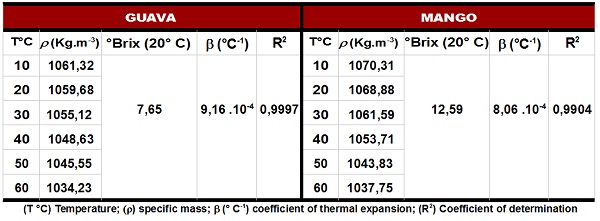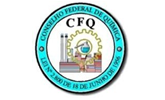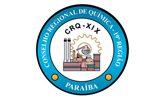ESTIMATIVE OF THE VOLUMETRIC EXPANSION COEFFICIENT OF GUAVA PULP AND MANGO THROUGH MATHEMATICAL CORRELATIONS
ISBN 978-85-85905-25-5
Área
Alimentos
Autores
Maia, I.A. (IFTO CAMPUS PARAÍSO DO TOCANTINS) ; Melo, E.S. (IFTO CAMPUS PARAÍSO DO TOCANTINS) ; Pereira, P.V.D. (IFTO CAMPUS PARAÍSO DO TOCANTINS) ; Viroli, S.L.M. (IFTO CAMPUS PARAÍSO DO TOCANTINS) ; Costa, L.F. (IFTO CAMPUS PARAÍSO DO TOCANTINS) ; Santos, M.R. (IFTO CAMPUS PARAÍSO DO TOCANTINS)
Resumo
Knowledge of the coefficient of volumetric expansion of fruit pulp is important for designing and evaluating equipment. The objective of this work was to determine the coefficient of volumetric dilation of guava and mango pulps as a function of specific mass and temperature variation from 10 to 60 ° C, at concentrations of 7,65 ° Brix and 12, 59 ° Brix respectively. The specific pulp mass was determined with the aid of pycnometers. The coefficients of volumetric expansion were performed through the ratio e ln ρ0 / ρ = β. (T-T0). The values of specific pulp masses decreased with increasing temperature and presented determination coefficients greater than 0,99 showing a good fit.
Palavras chaves
GUAVA ; VOLUMETRIC EXPANSION COEF; MANGO
Introdução
The coefficient of volumetric expansion (β) is an important thermophysical property for designing, sizing equipment and processes involving heat transfer (MATTOS, J.S.; MEDEROS, B. J. T., 2008). Knowledge of (β) allows us to study the density variation in response to a change in temperature under constant pressure, the expansion behavior, to evaluate the impacts on the volumetric measurement system due to temperature variation and to design equipment and accessories, considering possible dilations. resulting from strong temperature changes (INCROPERA and DEWITT, 2008; CANCIAM, 2014). The production, transportation and storage of fruit pulp involve important thermophysical properties for the correct sizing of equipment for these operations. (LIMA, 2003). Knowledge of the specific pulp mass behavior under processing conditions is essential as it changes during heat and mass transfer during food processing (Bolzan and Souza, 2007). During the pulp processing, heating, pasteurization, concentration and the use of low temperatures are used to preserve the quality of these products. (LIMA, 2003). Mathematical models for predictability of thermophysical properties represent an appropriateness of increasing the efficiency of heat treatments in food processing and an alternative to replacing the experimental determination of these parameters, which can be very costly for industry (EGEA et al., 2015). The objective of this work was to estimate the volumetric expansion coefficient of guava and mango pulps, from the linear regression analysis of experimental data of specific mass as a function of temperature.
Material e métodos
This work was developed at the General Chemistry Laboratory of the Federal Institute of Tocantins - IFTO Paraíso do Tocantins campus, from June to December 2018. Mango and frozen guava pulp were purchased at the local commerce of Paraíso do Tocantins - TO. The specific mass of guava and mango pulp were determined at temperatures of 10, 20, 30, 40, 50 and 60 ° C, at a concentration of 7,65 ° Brix for guava pulp and 12,59 ° Brix for mango. All experiments were performed in triplicate and the calculation was used at the average of the values obtained in the experiments. The pycnometers were previously calibrated with distilled water at each temperature of the experiment and the temperatures were controlled through the thermostat bath and the thermometers present in the experiments own pycnometers. The calculation of specific mass was performed through Equation 1, which establishes a relation between mass and volume. p = m / v (1) where, p - specific mass of the product (kg.m-3); v - Pycnometer volume (m3); m - Mass of product (kg). For the determination of the coefficient of thermal expansion, equation 2 was used, following the same methodology of CANCIAM (2012): In p0 / p = β (T-T0) (2) Where p0 and p correspond, respectively, to the specific mass of pulp at the initial temperature T0 and the specific mass of the pulp at the final temperature T. From these data it is possible to obtain the volumetric expansion coefficient determined by the graph line of In (p0 / p) versus (T-T0) (CANCIAM, 2010 ).
Resultado e discussão
Table 01 shows the experimental values of specific mass, coefficient of
volumetric expansion and coefficient of determination of guava and mango
pulps
as a function of temperature. Alves et al. (2017) obtained specific masses
of
1060,31 to 1044,48 kg.m-3 for guava pulp with 9,8 °Brix and
temperatures from 10 to 50 °C. Dantas Junior et al. (2007), performing
studies
to predict mango specific mass at temperature 10 to 50 °C, found a variation
from 1055,73 to 1009,38 kg.m-3. Mercali et al. (2011) found that
specific mass values decreased with increasing temperature probably due to
the
volumetric expansion of the fluid caused by the reduction of the
intermolecular
force bonding. Graphs 01 and 02 have shown the results for the volumetric
expansion coefficient β and correlation coefficient of the analyzed goose
and
mango pulps the same line of reasoning, the increase in mango pulp volume
varies
approximately 0,0806%. These values may seem small, but compared to water,
the
increase in guava and mango pulp volume corresponds to 4,43% and 3,89%,
respectively, times greater than the increase in water volume, considering
that
the (β) of water equal to 2,07.10-4 ºC-1 (CABRAL and
LAGO,
2002). Lira (2004) states that a linear correlation is classified as very
strong
when the modules of the correlation coefficient values are between 0,90 and
1,0.
Thus, according to the author's classification, guava and mango pulps
presented
a very strong correlation.

Mean values of specific masses, coefficient of volumetric expansion and coefficient of determination of guava and mango pulps

Conclusões
The specific mass values of the analyzed pulps decreased with increasing temperature, ranging from 1034,23 to 1070,01 kg.m-3 for guava pulp and 1038,06 to 1069,98 kg.m-3 for mango pulp consistent with the reported behavior for fruit pulp in the literature. Guava and mango pulps presented coefficients of volumetric expansion equal to 9,16.10-4 ºC-1 and 8,06.10-4ºC-1 respectively. The values found for the determination coefficients presented a significant and very strong linear correlation.
Agradecimentos
A DEUS AO IFTO CAMPUS PARAÍSO DO TOCANTINS AOS PROFESSORES PAULO VITORIANO DANTAS PEREIRA E SERGIO LUIS MELO VIROLI
Referências
ALVES, M.N.M.; SANTOS, D.A.; MELO, J.C.S.; COSTA, C.H.C. ; BADARO, A.D.S. Avaliação de modelos polinomiais para estimar a massa específica da polpa de goiaba. In: Congresso Brasileiro de Química - CBQ, 2017, Gramado RS. Congresso Brasileiro de Química - CBQ, 2017.
BOLZAN, T. G.; SOUZA, D. Estudo do comportamento da massa especifica de suco de laranja em função da temperatura e da concentração. XIX Salão de iniciação científica, Livro de resumos. Porto Alegre: UFRGS, 2007.
CABRAL, F.; LAGO, A. Física 2. Harbra, São Paulo, 2002. 516p.
CANCIAM, C. A. Predição do coeficiente de expansão térmica do óleo de gergelim (Sesamum Indicum L.) através da aplicação da análise de regressão linear. E-xacta, v. 3, n. 1, p. 21-28, 2010.
CANCIAM, C. A. Predição do coeficiente de expansão térmica do óleo de girassol através da aplicação da análise de regressão linear. Revista Brasileira de Tecnologia Agroindustrial, v. 6, n. 2, p. 852-863, 2012.
CANCIAM, C. A. Efeito da concentração na dilatação volumétrica do suco de amora-preta. Revista CIATEC – UPF, Passo Fundo: UPF, v. 6, n. 1, p. 26-36, 2014.
CALLISTER, W. D. Ciência e Engenharia de Materiais: uma introdução. Rio de Janeiro: LTC Ltda., 2008.
DANTAS JÚNIOR, E. E.; QUEIROZ, A. J. M.; FIGUEIREDO, R. M. F. Determinação e elaboração de modelos de predição da massa específica da manga espada. Revista Educação Agrícola Superior, v.22, n.1,p.39-42, 2007
DINIZ, R. S.; COIMBRA, J. S.R.; MARTINS, M. A.; SANTOS, M. O. ;DINIZ, M. D. M. S.; SANTOS, E. S.; SANTÁNNA, D. D.; ROCHA, R. A.; OLIVEIRA, E. B. Physical Properties of Red Guava (Psidium guajava L.) Pulp as Affected by Soluble Solids Content and Temperature. International Journal of Food Engineering, v.10, n.3, p. 437–445, 2014.
EGEA, M. B.; REIS, M. H. M.; DANESI, E. D. G. Aplicação de modelos matemáticos preditivos para o cálculo das propriedades termofísicas do palmito pupunha. Revista Brasileira de Produtos Agroindustriais, v.17, n.2, p.179-187, 2015.
INCROPERA, F. P.; DEWITT, D. P. Fundamentos de Transferência de Calor e de Massa. Rio de Janeiro: LTC Ltda., 2008.
LIMA, Í. J. E. D.; QUEIROZ, A. J. D. M.; FIGUEIRÊDO, R. M. F. D.Propriedades termofísicas da polpa de umbu. Revista Brasileira de Produtos Agroindustriais, Campina Grande, Especial, n.1, p.31-42, 2003
LIRA, S. A. Análise de correlação: abordagem teórica e de construção dos coeficientes com aplicação. 2004.Dissertação (Mestrado) – Programa de Pós-Graduação em Métodos Numéricos em Engenharia, Universidade Federal do Paraná: Curitiba. 2004.
MATTOS, J.S.; MEDEROS, B. J. T. Densidade de polpas de frutas tropicais: banco de dados e determinação experimental. BioEng, Campinas, v.2, n.2, p. 109-118, jan/abr., 2008.
MERCALI, G. D.; SARKIS, J. R.; JAESCHKE, D. B.; TESSARO, I. C.; MARCZAK, L. D. F. Physical properties of acerola and blueberry pulps. Journal of Food Engineering 106, 283, 2011.
NETZ, P. A.; ORTEGA, G. G. Fundamentos de físico-química: uma abordagem conceitual para as ciências farmacêuticas. Artmed, Porto Alegre, 2008. 299p.









